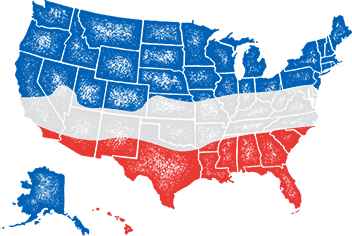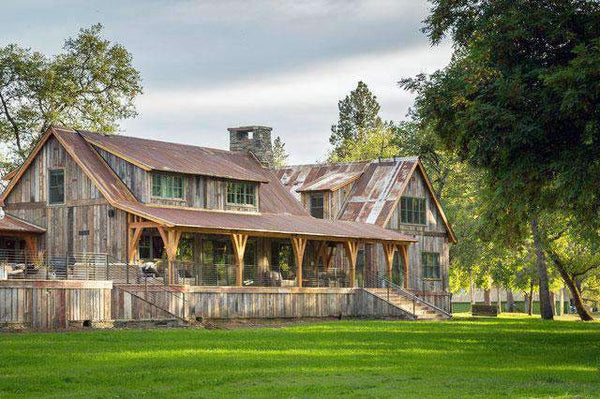Hancock's Ryegrass Seed is an Annual Ryegrass, used for lawn, pasture and forage applications around the world.
Product Information
- Application or Use: Lawn, Pasture, Cattle Forage, Cover Crop, Erosion Control
- Germination Time: 5 - 7 days, under optimal conditions
- Growing Locations: Warm Season, Transition Zone, Cool Season
- Height: Lawn - 1 - 3 inches - Pasture - 6 - 8 inches
- Sunlight Requirements: 4+ hours, full sun for best results
- Advantages: Provides soil stability in the winter and dies back in the spring, allowing your warm season grasses to flourish!
- When to Plant: Recommended planting time is fall and winter when night time temperatures are consistently below 65 degrees.
Seedlings quickly establish a ground cover and are very competitive. Hancock's Ryegrass Seed flowers in late May to early June, and matures between late June to early July.
Hancock's Ryegrass Seed can be used as a cover crop in annual or perennial cropping systems, or as forage, hay, or a nurse crop for legumes and permanent grasses. It can often be grown under conditions where other cover crops fail. It is an excellent choice for soil protection and weed suppression because it establishes quickly and grows throughout the fall and winter.
Hancock's Ryegrass Seed is suitable as a cover crop in grass waterways or riparian areas subject to flooding because it tolerates wet soils and temporary flooding. It is also commonly is used on poor soils, or on sandy or rocky soils, where it normally produces better growth than cereal species do. It is a good choice for fast, temporary cover on exposed areas with minimal seedbed preparation, such as construction and burned areas.
Hancock's Ryegrass Seed has been used successfully as a relay-planted cover crop in both short and tall-statured summer crops. Its smaller seed allows better seed-soil contact under marginal seedbed conditions than with cereal crops, and it is better at emerging from thick harvest residue (e.g., sweet corn). Hancock's Ryegrass is a heavy N feeder and can be used to scavenge N from the soil during the fall and winter, therefore reducing losses caused when rains leach nitrate below the root zone.
Hancock's Ryegrass Seed is GMO-free.
Ryegrass is a cool season variety, plant once nighttime temperatures are consistently 65 degrees and below.
*Product packaging may appear different than what is pictured.

Seeding rates vary depending on the intended use and the seeding technique. In general, relatively high rates of seeding are recommended, despite the relatively small seed size. When used as a cover crop, seeding rates range from 9-40 lbs. per acre. Use higher rates when broadcasting and when soil protection is important.
Suggested fall planting dates are from mid-September until mid-October. Best stand establishment is accomplished when annual ryegrass is drilled 1/2 to 3/4 inch deep into a firm, well-prepared seedbed. Alternative seeding methods that can reduce seedbed preparation but require higher seeding rates are: drill into a rough seedbed prepared by disking, or broadcast over a rough or smooth seedbed and then disk lightly to cover the seed. If the soil is dry, irrigate or plant before a Fall rain.
When relay interplanting, broadcast into a standing summer crop immediately before the final cultivation. Increase irrigation frequency while the Annual Ryegrass is germinating for more even establishment. Annual Ryegrass will germinate on the soil surface if adequate moisture is maintained.
In annual rotations, kill or incorporate Annual Ryegrass during spring with sufficient time for decomposition to occur before planting the summer crop. Excessive dry matter production can interfere with residue management, spring planting, and N availability to the following crop, so Annual Ryegrass usually is killed or incorporated when still somewhat succulent.
Higher rates of herbicide are required to kill Annual Ryegrass than cereal grain cover crops.
Annual Ryegrass often is grown in mixtures with legumes. Annual Ryegrass provides early protection of the soil, suppresses weeds, and acts as a nurse crop when seeded with legumes. However, due to its vigorous growth, Annual Ryegrass may smother companion legumes. Reduce Annual Ryegrass seeding rates to decrease annual ryegrass competition for light, water, and nutrients.
When used in perennial systems such as orchards and vineyards, Annual Ryegrass can reseed itself if mowing schedules permit seed production. If a temporary cover is desired, you should kill, incorporate, or mow Annual Ryegrass before seed is mature.
Annual Ryegrass is likely to tolerate mowing, unless flailed at ground level in very dry conditions, but even then it may survive.
Overseed existing lawns at 1-2 lbs. per 1,000 sq. ft. Overseed existing pasture areas at 25 - 50 lbs. per acre.
Ryegrass is a cool season variety, plant once nighttime temperatures are consistently 65 degrees and below.
Hancock's Ryegrass Seed
Hancock's Ryegrass Seed has achieved international acclaim, being implemented across both the United States and the rest of the world. It's easy to see why: This is a cost-efficient lawn, pasture, and forage product that has proven its value for decades.

Instructions
For more info on planting instructions and tips for the best results – check out our Warranty & Planting Information here!
Seeding rates vary depending on the intended use and the seeding technique. In general, relatively high rates of seeding are recommended, despite the relatively small seed size. When used as a cover crop, seeding rates range from 9-40 lbs. per acre....
Hancock's Ryegrass Seed
190Hancock's Ryegrass Seed has achieved international acclaim, being implemented across both the United States and the rest of the world. It's easy to see why: This is a cost-efficient lawn, pasture, and forage product that has proven its value for decades.































